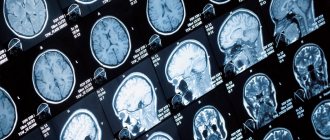Medical information is reliable Checked by Shaidullin Renat Flyurovich
Manic disorder (manic syndrome) refers to mental disorders and is most often found in bipolar disorder. The severity of manifestations varies even in the same patient, depending on the stage of the disease and the type of its course. Manic manifestations are observed as part of the symptomatology with disturbances of biochemical processes in the brain during infectious or intoxication psychosis, with organic lesions of the central nervous system. It can be provoked by the use of alcohol and drugs, and certain drugs. In turn, the disease often pushes a person to take psychotropic substances, which greatly aggravate the course of the disease.
Manic personality disorder: symptoms
The mechanisms of development of mood disorders have not yet been sufficiently studied, but its symptoms are well known. The main manifestations of manic disorder are described by a typical triad of symptoms:
- hyperthymia (inappropriate increase in mood);
- excitement (motor and mental);
- tachypsia (acceleration of thinking).
During this mental disorder there are several stages:
- hypomania;
- severe mania;
- manic frenzy;
- motor calming;
- reactive stage.
With hypomania, a person experiences an elevated mood, a feeling of cheerfulness, and elation. His speech speeds up and moderate motor agitation is noted. Some difficulties arise with the need to concentrate, distractibility increases, and constant switching to different topics or subjects. There is a slight decrease in the need for sleep and a slight increase in appetite.
In the stage of severe mania, a person experiences the same symptoms, but they gradually increase. Patients constantly make jokes and laugh. They begin to experience pronounced speech arousal with a violation of the semantic sequence. Against the backdrop of extremely positive expressions of emotions, outbursts of anger may occur. The idea of one’s own greatness dominates behavior and conversation. A person is overwhelmed with thoughts about wonderful prospects, can invest money in failed projects, but at the same time he stops taking care of himself, looks careless and sloppy. Sleep is reduced to 4 hours a day.
Manic frenzy manifests itself as follows:
- erratic motor agitation;
- complete lack of logic and connection in the conversation;
- insomnia;
- excessive appetite.
After this, the stage of motor calming begins, but speech excitation remains. There is a gradual decrease in the intensity of manifestations of mania. The reactive stage is manifested by the return of all symptoms to normal. Sometimes there is a slight deterioration in mood, inhibition of motor skills, thinking, and a feeling of fatigue. Some patients cannot remember details of behavior at advanced stages.
General information about the disease
Bipolar disorder is a disorder with alternating two affective phases: manic and depressive. There are several options for the presence of phases that determine the types of disease:
- Unipolar – periodically occurring exclusively manic or exclusively depressive stages.
- Bipolar - after the end of the manic phase, a bright period begins when the disease recedes. Following the period of health, a stage of depression begins, followed again by remission. The cycle is repeated many times.
- Incorrectly intermittent - phases alternate alternately through light periods without strict periodicity: it is possible to repeat two manic stages one after another, after which depression sets in;
- Double - one phase is directly replaced by another, only after this a light interval occurs.
- Circular - strict sequence in phase changes without light gaps.
BAR, in simple terms, is a disorder that combines periods of over-elevated mood with periods of low, decadent mood. That is, the person is too happy or too sad. Of course, all people experience periodic changes in their emotional background, but with bipolar disorder, such changes go beyond the norm, affecting a person’s functioning and quality of life.
The picture of the disease may involve only one emotional pole or both opposite poles. Between them, intermissions, interphases—light gaps—may appear. During this period, the patient’s mental state corresponds to the norm. Intermissions may be absent, then the disease takes on a continuous course.
The length of the alternating phases ranges from several weeks to several years, and on average takes 4–8 months. Manic episodes are several times shorter than depressive episodes. Intermissions last from 3 to 7 years.
The course of the disease may occur in rapid cycles. The rapidly cycling form can cause up to four episodes of the disorder phases per year. The stages may follow each other or be separated by intermissions. During this period, depression lasts 2 weeks, mania – 1 week. In the malignant form, the patient experiences 4 or more episodes in 1 month.
Since the course of depression is longer, it causes more damage to a person than mania. Depressive episodes leave an imprint on a person’s professional activity, disrupt connections with society, and create an imbalance in family relationships. People with bipolar disorder are 15 times more likely to commit suicide than the rest of the population.
It is difficult to determine the prevalence of the disease in society, which is due to the ambiguity in diagnosing the disorder, but it is believed that, on average, 1% of the world's population suffers from the disorder. Regarding the age trend, approximately half of the cases of the disease occur in the range of 25–45 years. Forms with both phases more often occur before the age of 25, with one - after 30.
Bipolar forms are more characteristic of men, unipolar - women.
Manic disorder: classification
Manic disorder does not always manifest itself in a sequence of specific stages. In some cases, there is variability in symptoms. Depending on this, the following types of this syndrome are distinguished:
- classic mania - there is a standard picture of mental deviation with all the inherent stages and transitions;
- hypomania – all signs are present, but are not so pronounced as to change behavior and greatly reduce the quality of life;
- hyperthymic – expressed exclusively in an elevated, joyful state;
- confused - only tachypsia is noted;
- angry – increased activity against the background of worsening mood, anger, irritability;
- manic stupor – excellent mood and acceleration of the thought process against the background of motor inhibition;
- unproductive mania – good mood and activity combined with mental retardation.
Also distinguished:
- paranoid variant of mania with delusions of relationships or persecution;
- delusional – based on a sense of one’s own greatness and exclusivity;
- oneiroid - at the height of manifestations of mania, fantastic hallucinations occur.
Clinical signs of the main types of paranoia
The disease worsens (symptoms are variable and differ depending on the specific form of paranoid syndrome) sharply, under the influence of any external factors.
Erotomanic
The patient is sure that someone has serious feelings for him. As a rule, the “object” of desire is a person standing noticeably higher on the social ladder (for example, a boss, an oligarch, a politician) or a well-known media personality (an actor, a musician). Delusional ideas can be of a purely romantic, spiritual nature, or even have overt sexual content.
Depending on the personality characteristics, the patient may keep such a “feeling” secret or make a lot of efforts to meet his “lover”. In the event of a categorical refusal, he easily “switches” to a new object.
Delusions of grandeur
People suffering from this form of paranoia are convinced that they have some kind of talent. These could be creative, paranormal abilities. Sometimes they are sure that they have a special relationship with very real personalities (the president, the head of the intelligence services) or an imaginary deity. The patient may declare himself the messiah, etc.
Marital paranoia
Accompanied by obsessive thoughts about the infidelity of a spouse or cohabitant. A person constantly tries to find confirmation of his suspicions, sees evidence of betrayal in any words and actions, and “appoints” someone to the role of “lover.” He can arrange a search, harass those around him with his thoughts, and strive with all his might to obtain a confession of infidelity. As a rule, such a situation ends in divorce, after which temporary relief occurs, but soon the delirium appears again. It can be directed either at a former spouse, or relate to a new relationship.
Paranoid persecution syndrome
It is characterized by obsessive thoughts that someone is actively interfering with the achievement of goals, trying to cause moral or material harm, or deceiving. Behavior is dominated by excessive suspicion, sometimes by overt aggression and anger directed at the “persecutors.”
Hypochondriacal
Confidence in one's own serious incurable illness is typical. The patient constantly looks for symptoms of pathology, goes to doctors, gets tested, listens to his own feelings and reacts sharply to the slightest changes in well-being. Often, hypochondriacal paranoia, the symptoms and signs of which are associated with an imaginary disease, is superimposed on psychosomatic disorders, which further aggravates the course of the disease.
Other forms of mental disorder
- the idea of wealth;
- obsession;
- intellectual delirium, in which the patient believes that only he is capable of understanding the laws of the universe or some particular branch of science, often puts forward contradictory thoughts about the creation and structure of the world.
How does manic-depressive disorder manifest?
In clinical practice, mania is most often observed as one of the phases of manic-depressive psychosis (MDP), when there is an alternation of two phases - mania and depression (bipolar disorder). If a person has only one type of affect, then they speak of unipolar MDP. Depending on their alternation, four types of violations are distinguished:
- correctly intermittent (consecutive alternation of depression and mania divided into a light interval);
- irregularly interspersed;
- double (when one manifestation replaces another without interruption, and then there is a gap);
- circular (the most severe in course, since switching from mania to depression occurs continuously).
The typical symptoms of manic disorder in the patient are replaced by signs of depression. In bipolar disorder it happens:
- simple;
- hypochondriacal;
- delusional;
- agitated;
- anesthetic.
With its simple form, the classic triad of symptoms is noted - decreased mood, slowed thinking, motor retardation. A person’s appetite disappears, weight decreases, and libido disappears. The symptoms are strongest in the mornings and somewhat subside in the evening. The hypochondriacal form is accompanied by a person’s belief that he is terminally ill. The agitated variety occurs without motor inhibition, and “jumps of ideas” are observed. Anesthetic is accompanied by a feeling of loss of feelings, instead of which an emptiness is formed, causing anxiety.
The depressive phase of MDD occurs in several stages:
- initial;
- increasing;
- expressed;
- reactive.
Initially, there is a slight decrease in mood, tone, and performance. With increasing depression, there is an increase in symptoms, the appearance of insomnia, anxiety, loss of appetite, and a complete loss of strength. At the advanced stage, the symptoms reach their apogee. The person suffers from anxiety, melancholy, his speech becomes quiet, his thinking is inhibited. Stupor is often observed when the patient remains in one position (sitting or lying) for a long time. Anorexia often occurs, delusional ideas with self-deprecation develop, and thoughts of suicide appear. During the reactive stage, all signs subside, and asthenia may persist.
In manic-depressive psychosis, an atypical manifestation of the depressive phase is often described. In this case, there is an increase in appetite, an increase in body weight, constant drowsiness, and emotional instability. The patient is characterized by high anxiety and irritability.
According to the American classification, there are two main types of bipolar disorder. The first (BAD I) is more characterized by manic and mixed types of affects. And with the second (BAD II) – hypomania and depression. The first type is more severe and is characterized by symptoms of severe mania. In the second case, depression brings discomfort, and the manic part affects the general well-being less and resembles a mild form of euphoria.
Bipolar disorder. A survival guide for those who often cannot see the white line
LIFE ON A ROLLER COASTER
“I am a person of mood. When I'm in the mood, I can move mountains. When I don’t, I can’t even bring myself to wash my hair.”
“It’s very difficult for me to plan anything because I don’t know what I’ll be like in at least a week. Maybe a superhero, maybe a pathetic loser."
“Even when I’m in a calm mood, I’m worried: it could end any day.”
“I am an enthusiastic person: I often come up with and start something new, I immerse myself in it headlong. And then I run out of energy, I give up everything, and it’s unpleasant to even remember my previous hobby.”
“My life seems to go in a circle: a rise when I achieve everything, then a decline when I lose almost everything, and each time I have to start all over again.”
“It’s as if two or even more personalities live inside me, they have different characters, different interests, and they look different.” “Everything with me is either too wonderful or completely terrible, everything with me is too much.”
“I don’t need doping, it’s like my brain produces drugs on its own.”
“The ups wear me out, and the downs drain me. I don’t know if my life is ever normal?”
“I don’t even know who I really am.” “My life is complete chaos.”
This is how people with bipolar disorder describe themselves and their lives. If you recognize yourself, someone close or familiar, then you have chosen the right book! This is the first guide to surviving bipolar disorder in Russia. In it we have collected relevant and practical information about bipolar disorder and how to organize your life with this feature. In the first part of the book we will tell you what bipolar disorder is and what it looks like from the inside and from the outside.
What is bipolar disorder
Bipolar affective disorder (abbreviated as bipolar disorder, code F31 in the International Classification of Diseases, 10th revision and 6A60 in the future ICD, 11th revision) is a chronic mental illness in which periods of normal mood alternate with episodes of increased (hypomania and mania) and decreased (subdepression). and depression) mood.
Between episodes, the person usually recovers completely. Episodes are also called phases or attacks of illness, and the periods of a healthy state between them are called intermissions, light intervals or euthymia.
Bipolar disorder is classified as a mood disorder, as are various types of depression. This means that it manifests itself primarily in disturbances in the emotional sphere.
Bipolar disorder does not lead to personality degradation, does not reduce mental abilities, and does not deprive a person of legal capacity. But at the same time it is considered a serious illness from the field of “big psychiatry” on a par with schizophrenia, and one of the most dangerous due to the high suicidal risk.
To understand why mood disorders are dangerous, let's remember the role emotions play in our lives. Mobile and changeable emotions have an extremely important function: they help to quickly navigate in any situation and respond adequately to it.
The prevailing emotions in a person form the mood - that is, the general emotional background. It depends not only on external events, but also on temperament. For example, a sanguine person (who is called hyperthym in modern psychology) has a heightened emotional background; he will react to any events more positively and energetically than, say, a phlegmatic person.
Emotions play a key role in communication, warning us of danger, and also “rewarding” or “punishing” us for actions that we consider right or wrong. We even think thanks to emotions: intuition, insight, creative inspiration - all this is the result of the work of emotions.
As noted emotion researcher Paul Ekman, emotions motivate our lives and determine the quality of our lives. After all, we evaluate various events, the people around us and our lives in general not by some objective criteria, but by the emotions that all this evokes in us. Some psychologists believe that people make almost all decisions at the level of emotions, and the mind only rationalizes them. Emotions can be even stronger than basic instincts: hunger, sexual desire and the desire to survive.
Now imagine that the response system carefully balanced by nature is broken. Emotions stop reflecting the surrounding reality and begin to live their own lives.
For example, everything is going great for you, you graduated from a prestigious university, and received several promising job offers. But you are not interested in anything. You hate yourself and your life and only want to be left alone. Or, on the contrary, you were fired from your job, broke up with your loved one, but there is a feeling of celebration in your soul, and you take out a loan to continue having fun.
If you are stuck in one state or another for a long time, if the strength and duration of emotions are not related to life circumstances, you can talk about a mood disorder.
Mood can be chronically low, even when everything is great, or high, despite many problems. Or it may be that throughout life, cycles of extremely good and extremely bad moods alternate, as happens with bipolar disorder.
There is no single picture of bipolar disorder. The phases can alternate at different frequencies and in different orders. The combination and strength of symptoms also varies from patient to patient. For example, someone develops one hypomania after several depressions. For some, episodes are isolated, and between them there are years of remission. And there are bipolar people in whom mania and mixed states predominate (in which symptoms of mania and depression are present simultaneously), but there is almost no depression.
It's fair to say that every bipolar person is bipolar in their own way. As a rule, in the life of one person a typical set of symptoms is repeated.
Bipolar disorder is currently considered an incurable disease. This means that ups and downs can be repeated throughout life. Their frequency and severity can be reduced with the help of medications, but the therapy available today does not guarantee complete relief from symptoms.
The treasured word “remission”
The long-term absence of mania and depression is called remission. It can occur spontaneously, but most often due to long-term use of medications. Remission can last for several months or several years, and in some lucky cases it lasts for life.
It is not always possible to adequately assess your own condition, so if you want to make sure that you are on the mend, find out the opinion of your doctor. Quite often, bipolar people mistake hypomania for recovery.
What are the chances of going into long-term remission with bipolar disorder, that is, becoming a virtually healthy person again?
There is no clear answer to this question, since remission depends on many factors. We will present the most basic ones.
1. A well-chosen treatment regimen. Statistics show that mood stabilizers used to treat bipolar disorder improve the condition of 70–80% of patients. It has been proven that they can extend the life of a person with bipolar disorder by several years and significantly improve its quality.
2. Length of illness. The sooner a person receives a correct diagnosis and begins treatment, the greater his chances of remission. And, on the contrary, the more manias and depressions he has experienced, the more difficult the future prognosis.
3. Lifestyle. In the following chapters, we will examine in detail which habits and skills help maintain balance, and which, on the contrary, put it at risk.
In addition to clinical remission, which implies the absence of symptoms, there is also the concept of “functional remission”. It means returning to healthy functioning as a member of the family, community, professional, and so on (depending on what is important to the individual). Functional remission depends not so much on pills, but on psychological conditions: can a person organize life taking into account his limitations, build a regime, are there people around who are ready to support him.
On the one hand, many bipolar people are able to maintain high functionality even in the presence of symptoms. On the other hand, each attack of acute mania or depression unsettles a person for a long time, and it often takes months to recover psychologically. Psychotherapy can help with this process.
It is important to consider that remission must not only be achieved, but also maintained. A person with bipolar disorder remains more vulnerable to stress throughout their life than someone without it. In addition, many people continue to have so-called “residual symptoms” - periods of depression, irritability, anxiety, and decreased mental abilities. Therefore, balance, if you managed to achieve it, must be carefully preserved, and not test the strength of your psyche. In particular, a chaotic lifestyle and substance abuse increase the risk that mania and depression will return.
Just the facts
The first symptoms of bipolar disorder appear at a young age: in more than half of cases - before the age of 18, in the vast majority of cases - before the age of 30.
Most often, the first episode of the disease occurs at 15–25 years of age. Moreover, the earlier the disease begins, the more severe it is. Bipolar disorder can manifest itself in both childhood and old age, but this occurs quite rarely.
As a rule, the disorder begins with depression, although in men hypomania often occurs first.
On average, one person experiences 10 episodes in his life (if untreated). But with a rapid change in cycles of disease attacks, there can be more than 50.
Bipolar disorder often leads to disability and disability. Globally, according to the World Health Organization (WHO), it is the 12th most common cause of disability. More people become disabled due to symptoms of bipolar disorder than due to asthma, and almost as many as due to coronary heart disease.
Due to the difficulties of diagnosis, even in Europe, people find out their diagnosis only 10 years after the initial visit, which, of course, prevents timely treatment.
How many bipolar people are there in the world?
This is a less common disorder than depression, but still not uncommon.
Most studies in the 80s and 90s showed that it affects 1-2% of all people.
Modern studies, which use more subtle diagnostic methods and take into account relatively mild forms, show impressive figures - more than 5% for bipolar spectrum disorders.
The prevalence of bipolar disorder type I is about 1% of the population, type II is about 1.5%.
Statistics for different countries vary greatly. Most likely, this is largely due not to the prevalence of the disease, but to the characteristics of the healthcare system and the collection of statistics.
If we look at the available data, we see two poles: the most diagnosed bipolar people are in the USA (4.4%, that is, more than four people out of 100), the least in Russia (0.036%, or less than one person in ten thousand!) .
In the analytical review of the Ministry of Health for 2011 (newer data is not yet publicly available), only 8,700 people were registered with a diagnosis of bipolar disorder throughout the country! At the same time, the number of patients with schizophrenia, which is considered a rarer disease, exceeds 500 thousand.
This speaks to at least two features of domestic psychiatry: firstly, state psychiatric hospitals (data from private clinics are not included in official statistics) diagnose bipolar disorder much less often than they should. Secondly, most bipolar people never seek treatment.
Risk of suicide
Bipolar disorder is considered one of the most dangerous mental illnesses. Between 20 and 60% of bipolar people have attempted suicide. From 4 to 19% (according to various studies) died for this reason. This is more common than in chronic depression or schizophrenia.
The risk of suicide exists with depression of any severity, because each person has his own limit of ability to endure suffering. But there are factors that significantly increase the danger. This is, according to research:
• Disease phase . The most dangerous periods are considered to be psychotic depression and mixed states, especially at the end of a depressive episode: in these states, thinking is focused on the negative, but at the same time there is strength to plan and commit suicide.
• Dual diagnosis . A dangerous combination is bipolar and borderline disorder (BPD) in one patient. Such people are prone to self-harm, impulsive and destructive behavior, especially under stress. At the same time, due to the demonstrative nature of “border guards,” loved ones often do not take their threats seriously. The combination of bipolar disorder with alcohol or drug addiction also increases the risk of suicide.
• Suicide of a loved one . A family history of suicide or the recent suicide of a friend significantly increases the risk. This is a scenario that can repeat itself.
• Gender and age. Men are more likely to die from suicide than women. But women are more likely to make attempts, including with serious health consequences. At risk are adolescents and young men whose symptoms appear for the first time. They have neither the experience nor the understanding of how to deal with it.
Bipolar disorder or manic-depressive psychosis?
Many people have heard the expression manic-depressive psychosis (MDP). And those who were treated during the Soviet era have exactly this diagnosis. BID is an outdated name for bipolar disorder that is still sometimes used today.
Used in Europe and Russia, ICD-10 replaced this term with BAR in 1989. The term was considered incorrect because it stigmatizes patients and at the same time inaccurately characterizes the disease itself.
As it turned out, bipolar disorder does not always develop psychosis, and in many cases there is no mania.
There is still ongoing debate among doctors and patients about which name is more appropriate. Clinical psychologist Kay Jamieson and author Stephen Fry prefer the term "manic-depressive illness" because they believe it more accurately conveys the essence of the disorder.
Diagnosis of manic-bipolar disorder
The criterion for diagnosing the disease is at least two recorded states of affect, provided that one of them represents a manic disorder. The Altman scale is usually used to identify impairment, and the Young rating scale helps to understand severity. The most important thing in confirming the disease is the exclusion of other pathological conditions that may be accompanied by mania:
- hyperstimulation after taking drugs or medications;
- schizophrenia;
- neurosis;
- infectious diseases;
- oligophrenia;
- psychogenic pathologies;
- intoxication;
- injuries;
- dysfunction of the thyroid gland.
More than half of patients with MDP also suffer from other types of mental disorders. This phenomenon in science is called “comorbidity”. Bipolar disorder is often combined with anxiety and substance abuse. Often, against the background of alternating mood swings, eating disorders, OCD (obsessive-compulsive disorder), and attention deficit disorder are observed.
Female factor
In women, the disease occurs with its own characteristics. In particular, we are talking about periods of hormonal changes: menstruation, pregnancy and childbirth.
Bipolar disorder often develops against the background of menstruation, especially when it first begins. The risk of developing bipolar disorder increases if a woman was exposed to psychotic attacks or took psychotropic drugs before pregnancy and childbirth. The likelihood of developing the disease increases 4 times if a psychotic episode occurs within two weeks after birth.
There is also feedback. For female representatives with the disorder, pregnancy and the postpartum period are more difficult. A certain problem is the question of whether or not to take psychotropic drugs during pregnancy. The fact is that such drugs have an undesirable, teratogenic effect on the fetus. On the other hand, it is very difficult to survive a strong hormonal surge in bipolar disorder without psychotropics.
There is an opinion that pregnancy can save a woman from depressive and manic attacks. It is a myth. Rather, on the contrary, the attacks will intensify. According to a study, 70% of expectant mothers experience mania or depression, which predominates in the first trimester. The only way out is medication support for the pregnant woman. It has been established that exacerbation of the disorder occurs twice as often in those pregnant women who interrupted drug treatment at the onset of conception.
Girl, 28 years old: “Even at school, I had bouts of depression. The only thing that saved me was the medications that I still take. Having become pregnant, I decided to stop taking the medications. As a result, I cried at the gynecologist, regretting that I got pregnant. It seemed that my Self was resisting the changes in life and body caused by the baby. The doctor convinced me to resume taking the medications. The condition has returned to normal."
Despite the possible risks that psychotropics pose to a child, refusing to take them suddenly and immediately is a rather rash decision. Depression provoked in this way can cause fetal malnutrition and premature birth. Manic states threaten dangerous behavior for the expectant mother and child, including suicide. The only correct decision in such a situation is a consultation with a psychiatrist. The specialist will select a more gentle drug, and in case of mild disorder, will prepare a scheme for gradual withdrawal of the medication.
The most dangerous period for a patient with bipolar affective disorder is postpartum. Polar attacks of the disorder occur in 40–60% of cases and last at least two weeks. If a woman resumes or continues taking medications during this period, the risk is reduced to 10%.
Treatment of manic disorder in Moscow
Manic disorder of a secondary nature should be treated by stopping the causative disease. To eliminate affect in MDP and prevent another exacerbation, mood stabilizers (mood stabilizers) become the drugs of choice. These include drugs with lithium, antiepileptic drugs, atypical antipsychotics. Depending on the severity of the disease, its stage and characteristics of manifestation, both monotherapy and the combined use of medications are used.
The main goal of treating psychosis in a discrete course is to achieve long-term remission. If bipolar disorder occurs with continuous changes in phases, the goal of treatment is to reduce the manifestations of the disease.
To stop one of the phases, high doses of drugs or their rapid increase to optimal doses are required. This happens with constant monitoring of the patient’s condition. Among specialists, this method is called “aggressive psychopharmacotherapy” and is used to prevent the development of resistance. The need for medical supervision of the patient is also due to the fact that in bipolar disorder there is a risk of drug-induced phase inversion.
Assistance in the manic phase is carried out using mood stabilizers. And if it is necessary to eliminate the signs of a mixed type of MDP, atypical antipsychotics are used in combination with lithium drugs. Typical antipsychotics are not used in this case, since such patients are likely to develop extrapyramidal disorders.
The use of antidepressants to relieve the depressive phase of bipolar disorder is still disputed by many experts. They argue for their position by the high risk of developing a manic stage in patients and provoking emotional lability. Therefore, the standard of treatment in this case remains mood stabilizers, the dosage of which requires careful selection under the control of the patient’s behavior. In some cases, it is necessary to resort to the use of antidepressants, but only in short courses and in combination with behavior stabilizers. Then the inversion can be avoided.
Antidepressants are selected depending on the main manifestations of depression. When there is a decrease in activity, apathy, or melancholy, stimulant drugs are used. In cases where anxiety and anxiety predominate, anti-depression medications with a sedative effect are used.
Diagnostics
The clinical picture plays a major role in making a diagnosis. Symptoms can only be assessed by a psychiatrist after a comprehensive life history collection. Laboratory and instrumental studies are of little significance. The criteria for bipolar disorder must correspond to those specified in the International Classification of Diseases (ICD-10), which are used in the protocols for providing assistance to the Russian Federation.
Mental status is examined not only at the time of examination, but throughout the entire history of the disease. The patient’s complaints, symptoms observed from others (by others), and the age of first manifestations are taken into account. Relatives must honestly talk about the peculiarities of raising children, the presence of hereditary burden of (any) mental illnesses, including through generations.
An important diagnostic point is assessing the risk of suicide. The most commonly used is the Columbia scale. Self-harmful behavior and preparatory actions are also included in the criteria for severe MDP.
Manic affective disorder: psychotherapy
To obtain long-term remission in manic disorder or MDP, both medications and modern psychotherapeutic techniques should be used. Only in this case can a stable and long-term remission be achieved. Its tasks are:
- expansion of self-knowledge;
- building a personality project;
- formation of an adequate self-image;
- training in self-control skills;
- improvement of functioning in the professional sphere and society.
The circumstances of any person’s life are replete with stress, which are risk factors for manic disorder and MDP. Psychotherapy helps to cope with them and prevents another exacerbation.
The following methods of psychotherapy are considered the most effective for this disease:
- cognitive-behavioural;
- interpersonal;
- family;
- social support;
- rhythm therapy;
- compliance therapy.
According to the protocol for the treatment of bipolar disorder, cognitive behavioral therapy takes first place in preventing the development of affects. It helps identify the patient's irrational thoughts, unproductive or harmful ideas and emotions. The technique changes them to constructive ones and thereby indirectly affects the biochemical processes of the brain. As a result of successfully conducted interpersonal therapy, a person learns to manage his reactions, change negative to positive, and thereby maintain a sufficient level of serotonin. He is able to identify early signs of hypomania or depression, and take measures to relieve them before the development of pronounced symptoms of pathology. His vulnerability to situations that act as disease triggers is reduced.
Family emotionally focused therapy has also shown high effectiveness in the complex treatment of patients with manic disorder.
It allows the patient:
- accept the inevitability of the occurrence of affective states;
- understand your needs and express them out loud;
- make sure of the need for lifelong intake of mood stabilizers;
- learn to resist stress and difficulties that provoke MDP.
Many people suffering from manic-depressive disorder sometimes lack words to explain their feelings. Instead of saying that they need attention, warmth and care, they talk about their desire to die. The patient’s relatives perceive his behavior negatively and react with anger or irritation. His depression does not cause understanding, since a healthy person does not see a reason for a bad mood, and mania is seen as a manifestation of negative character traits.
Therefore, it is important for the patient’s family members to participate in therapy, it provides the opportunity to:
- separate the manifestation of the patient's true personality from the symptoms of his illness;
- restore emotional connections after the negativity caused by mood swings.
Rhythm therapy is also very important for people with this condition. They are highly sensitive to sudden changes in periods of sleep and wakefulness. Manic disorder is often triggered by an event that leads to a change in the usual schedule. For this reason, teaching patients to control rhythms reduces the likelihood of developing affect and significantly improves the prognosis of the disease. During the manifestation of the disease, rhythm disturbances also occur. therefore, the use of planning and a sense of control over one’s life and its effectiveness also have a beneficial effect on the condition, sometimes allowing one to avoid another relapse. It is important to have outside support at the same time, since during a period of depression a person’s self-esteem decreases and the desire to do anything disappears. Therefore, it is better if a loved one, friend, or psychotherapist helped in drawing up a plan and monitored its implementation.
Comparing one’s deviation with similar problems in other patients, regardless of whether they tolerate mood swings worse or better, also has a positive effect on a person’s condition. Therefore, the patient is recommended to attend self-help groups. There, anyone can honestly and frankly talk about their problems, discuss them, and receive support and approval. As studies by foreign clinical psychologists indicate, such openness helps not to isolate oneself from one’s illness, helps reduce its acute manifestations and prolongs the course of remission.
For manic disorder combined with depressive episodes, taking responsibility therapy is also beneficial. Its task is to help a person not to try to get away from problems, but also not to allow them to take over and destroy themselves. At the same time, the patient receives skills to manage his emotions. In essence, mania is an escape from suffering; during this period, the body produces a huge amount of neurotransmitters and uses them up. It is not surprising that after this their supply dries up and loss of strength and depression sets in. Then special exercises help to eliminate the depressed state.
Causes of psychotic syndrome
The main etiological factors of the disease are:
- endogenous: hereditary predisposition associated with congenital, genetically predetermined disorders of the functioning of individual brain structures, transmission of nerve impulses, information processing, accumulation and use of experienced experience;
- psychogenic: severe stress in one way or another affects the psycho-emotional state of any person;
- organic, associated with diseases of the central nervous system.
But as a rule, it is impossible to single out any one cause of psychomanic personality disorder, so experts are convinced of the polyetiological nature of the disease. Genetic predisposition only increases the risk of developing the disease, but trigger factors may include:
- neoplasms in the brain: aneurysms, hematomas, cysts, tumors;
- complications after brain surgery, ischemic or hemorrhagic stroke;
- acute or chronic intoxication with drugs, alcohol and other poisons;
- suffered a severe infection with neurological complications (meningitis, encephalitis, etc.) or other hidden chronic pathologies (for example, syphilis, HIV);
- complicated pregnancy and childbirth: acute fetal hypoxia, placental insufficiency, defects in the development of the central nervous system under the influence of teratogenic factors, etc.;
- a stressful situation that is painful for a person.
As practice shows, perfectionists, people who strive to completely control all areas of not only their lives, but also those around them, are predisposed to the development of manic personality disorder. They are confident and ready to prove that they are right; they are offended when people try to argue with them or do not follow their advice.
When psychotherapists ask patients about their childhood, they often talk about problematic relationships with parents, total control on their part, punishment for the slightest offenses, lack of interest in the problems and inner world of the child.
As for the pathogenetic mechanism of development of manic personality disorder, most experts adhere to the biochemical theory. The initial link in pathogenesis is a violation of the production, metabolism and sensitivity of central nervous system cells to the action of catecholamines (dopamine, adrenaline, norepinephrine) and endorphins (in particular, serotonin).
Such changes “trigger” a whole cascade of biochemical reactions that lead to disruption of hormonal levels and electrolyte balance. This predetermines an inadequate emotional reaction to certain events.
Questions and answers
What should you do if you notice signs of bipolar disorder?
It is difficult for a person to make a diagnosis on his own. To clarify it, you should visit a psychiatrist. If the disease is confirmed, then it is necessary to stay in the hospital for some time under observation and select the correct supportive therapy. Otherwise, the disease will worsen and will largely control life, reducing its quality. This will affect work, family relationships, and relationships with other people.
If you are diagnosed with this, is it for life?
Once the diagnosis of MDP is confirmed, you will have to constantly monitor your emotional state. This can be compared to regularly checking a diabetic's blood sugar levels. Usually, after proper selection of stabilizing therapy, you can stay in the “light phase” for a long time. But at the same time, we should not forget that the patient himself has a problem; he needs to lead a correct lifestyle, exclude the use of alcohol and drugs, and engage in self-observation and self-regulation.
How often do you need to visit a doctor for MDP?
For a patient with recurrent mania and depression, constant cooperation with a doctor and timely warning of changes in condition are required. Many patients need to take medications on an ongoing basis and monitor their health several times a year by undergoing general tests. Mild cases of MDP can be discontinued from medications, but the person needs to keep a diary or monitor their emotional background in other ways in order to detect the disorder in time and take action. It is advisable to visit a psychotherapist.
Manic phase of depressive psychosis
As the start of pathology, the manic phase is identified several times less frequently than the depressive state. Most patients, even at the stage of hypomania, rarely turn to specialists on their own, considering this condition to be the norm. Patients usually pay attention only to increased activity, which they perceive rather positively.
Characteristic manifestations become:
- increased disinhibition;
- unhealthy shine in the eyes;
- circumlocution;
- the present, future and past are perceived in rainbow colors;
- increased level of perception of one’s own strength and attractiveness;
- unhealthy optimism and a sense of limitlessness of one’s own possibilities.
The patient notices all the little things. He strives to communicate, notices all the little things. Tends to contact people without assessing the adequacy of the communication initiated, memory improves. A characteristic feature is an excessively positive perception of new acquaintances and emerging dissatisfaction with representatives of the close environment. In relation to the latter, the patient often becomes overly demanding and capricious.
The manifested disinhibition often becomes the reason for committing rash acts, sexual promiscuity, and inadequate financial spending.
Manifestations of the stage in children are poorly described, as they are less common. Young patients suffer from hyper-reactivity, they are verbose and agitated.









